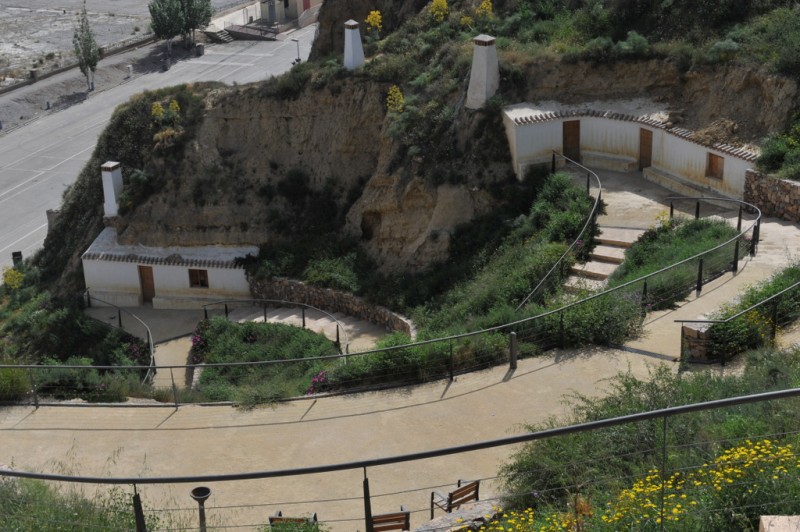- Region
- Águilas
- Alhama de Murcia
- Jumilla
- Lorca
- Los Alcázares
- Mazarrón
- San Javier
-
ALL AREAS & TOWNS
- AREAS
- SOUTH WEST
- MAR MENOR
- MURCIA CITY & CENTRAL
- NORTH & NORTH WEST
- TOWNS
- Abanilla
- Abarán
- Aguilas
- Alamillo
- Alcantarilla
- Aledo
- Alhama de Murcia
- Archena
- Balsicas
- Blanca
- Bolnuevo
- Bullas
- Cañadas del Romero
- Cabo de Palos
- Calasparra
- Camping Bolnuevo
- Campo De Ricote
- Camposol
- Canada De La Lena
- Caravaca de la Cruz
- Cartagena
- Cehegin
- Ceuti
- Cieza
- Condado de Alhama
- Corvera
- Costa Cálida
- Cuevas De Almanzora
- Cuevas de Reyllo
- El Carmoli
- El Mojon
- El Molino (Puerto Lumbreras)
- El Pareton / Cantareros
- El Raso
- El Valle Golf Resort
- Fortuna
- Fuente Alamo
- Hacienda del Alamo Golf Resort
- Hacienda Riquelme Golf Resort
- Isla Plana
- Islas Menores & Mar de Cristal
- Jumilla
- La Azohia
- La Charca
- La Manga Club
- La Manga del Mar Menor
- La Pinilla
- La Puebla
- La Torre
- La Torre Golf Resort
- La Unión
- Las Palas
- Las Ramblas
- Las Ramblas Golf
- Las Torres de Cotillas
- Leiva
- Librilla
- Lo Pagan
- Lo Santiago
- Lorca
- Lorquí
- Los Alcázares
- Los Balcones
- Los Belones
- Los Canovas
- Los Nietos
- Los Perez (Tallante)
- Los Urrutias
- Los Ventorrillos
- Mar De Cristal
- Mar Menor
- Mar Menor Golf Resort
- Mazarrón
- Mazarrón Country Club
- Molina de Segura
- Moratalla
- Mula
- Murcia City
- Murcia Property
- Pareton
- Peraleja Golf Resort
- Perin
- Pilar de la Horadada
- Pinar de Campoverde
- Pinoso
- Playa Honda
- Playa Honda / Playa Paraíso
- Pliego
- Portmán
- Pozo Estrecho
- Puerto de Mazarrón
- Puerto Lumbreras
- Puntas De Calnegre
- Region of Murcia
- Ricote
- Roda
- Roldan
- Roldan and Lo Ferro
- San Javier
- San Pedro del Pinatar
- Santiago de la Ribera
- Sierra Espuña
- Sucina
- Tallante
- Terrazas de la Torre Golf Resort
- Torre Pacheco
- Totana
- What's On Weekly Bulletin
- Yecla


- EDITIONS:
 Spanish News Today
Spanish News Today
 Alicante Today
Alicante Today
 Andalucia Today
Andalucia Today
The cave houses of Puerto Lumbreras
An ethnographic museum now occupies some of the restored cave homes of Nogalte
Puerto Lumbreras is home to an interesting and unusual museum complex housed within a number of restored cave houses, cut into the hillside surrounding the former Moorish fortress.
These contain a number of different themed displays examining the history of the municipality, its water supply structure, the fortifications, life in the cave houses, as well as local rural traditions and crafts and can be visited alongside the fortress complex; Medina Nogalte.
Cave houses were popular in this area and across the border in Almería, cut into the hillside with simple tools and offering straightforward accomodation which could easily be extended as required.
Many have fallen into disuse, but this complex has been restored to complement the fortress remains and show how much of the hillside would have been used after the fortress was abandoned.
Much of the expansion of Puerto Lumbreras took place in the 18th century (see History of Puerto Lumbreras) and the hill on which the Moorish fortress had been originally built, before later being occupied by the Christian forces of the Reconquista in the 13th century, then abandoned once the Moors were expelled from their last stronghold in Granada at the end of the 16th century, attracted some of the less financially secure new residents, who literally dug into the soft rock and created cave dwellings looking out over the farmland below.
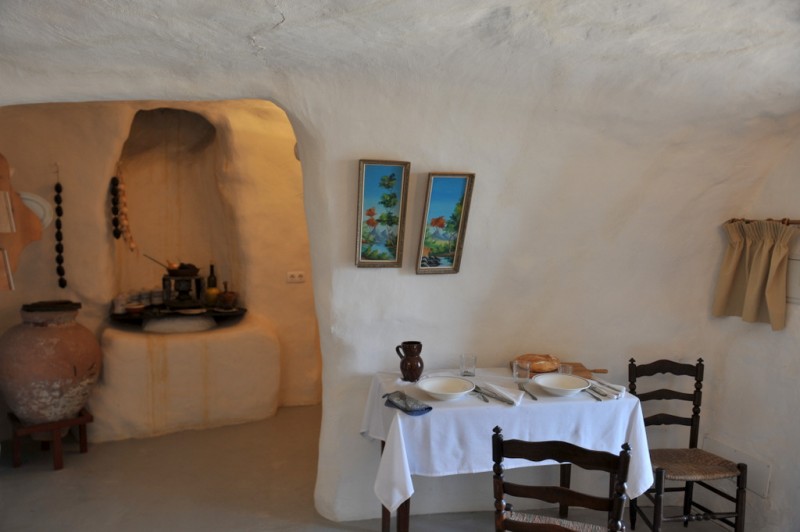
At one point over 140 of these modest caves were occupied, constituting a sizeable community living in conditions which at first sight appear to many to be almost unbelievably primitive. However, during the 20th century the inhabitants gradually succumbed to the temptation of moving down to the more conventional homes of the town of Puerto Lumbreras, and they became practically uninhabited.
There is one exception, though: one of the cave houses is still occupied by a lady who has spent all her life there and says that she has no intention of abandoning the comforts of her cave and living “like a rabbit” in an apartment block. A video of an interview with this remarkable woman is part of the guided tour of the caves, and although her accent is thick (subtitles in Spanish are provided!) she explains that now that she has been supplied with electricity she has everything she needs, and feels as wealthy as she could possibly be.
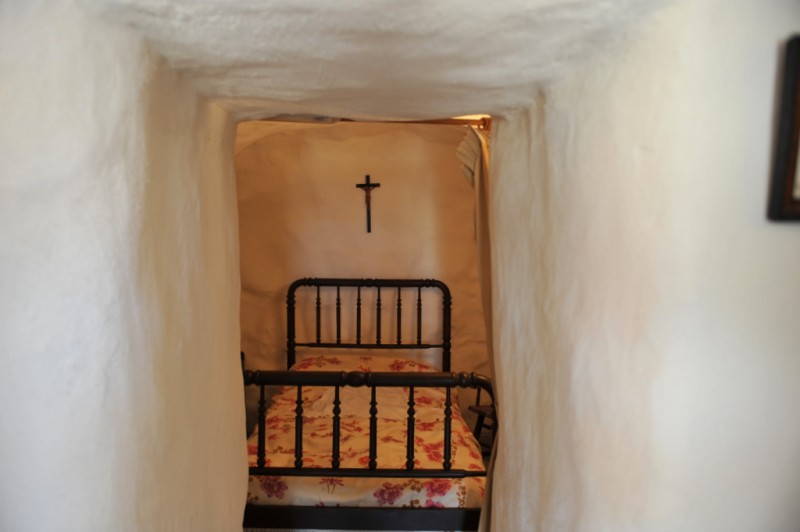
Life in the cave houses
This sole remaining occupant of the cave houses of Puerto Lumbreras still remembers, though, what life was like before the addition of “mod cons” to her home.
The first thing which strikes visitors to the caves today is probably their size: they are tiny in all dimensions, particularly height, and this is despite the fact that the floors of the visitable homes were lowered during the restoration which has been carried out in recent years.
The caves were dug into the clay-based rock of the hill using simple tools, and extended as and when necessary: so, if a new baby was on its way, the father of the household took out his axe, chisel or whatever tool came to hand and either extended a bedroom or created a new one!
One of the features of homes of this kind, of course, is that there is very little natural light in any part of them except for the front room. For this reason, bedrooms were no larger than was necessary for the occupants to lie down, and the design and distribution of the caves is minimalist and functional.
On the other hand, the underground location means that the temperature is almost constant inside: the residents here were immune to the heat of summer and the cold of winter, and the lady in the video interview recalls that for as long as she can remember her bedclothes have consisted of “two blankets in winter and two blankets in summer”.
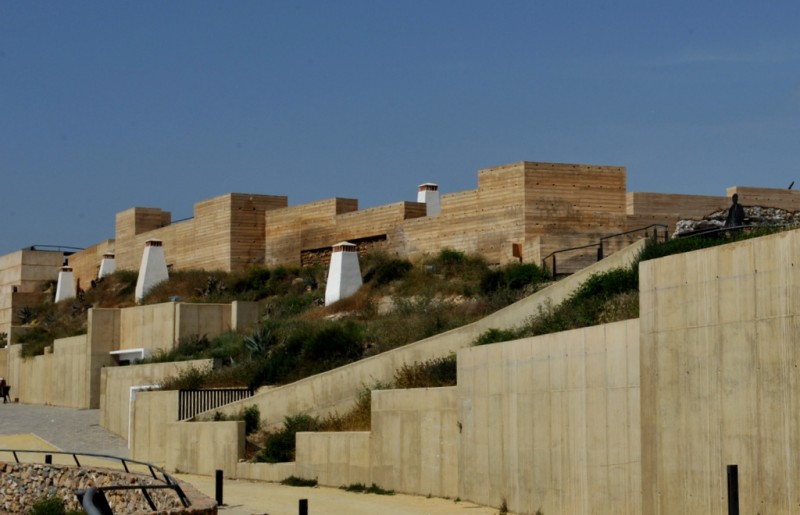
In many cases this comfortable temperature was shared at night by the animals such as goats and poultry which were kept by the human occupants.
Cooking was on a small fire which required the creation of a chimney leading out onto the hillside above, and these chimneys are the most obvious outward sign of the existence of the warren of rooms and dwelling on the hill.
But most of everyday life took place outside the houses, where the women undertook the daily task of washing clothes as a communal activity at a shared facility, food preparation and handicrafts, which either supplied a form of income or met the daily needs of the family.
This seems like an almost medieval way of life, but as recently as the early twentieth century the population was so great that one of the caves was even used as a schoolhouse!
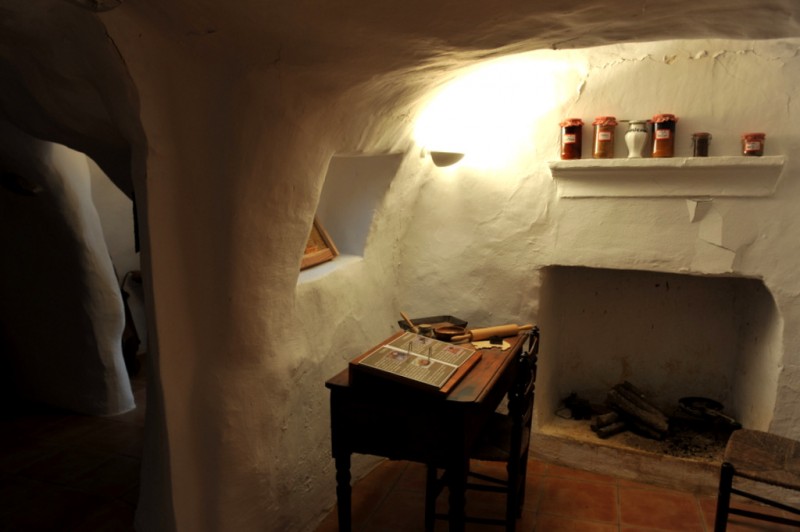
The restored caves
In all, nine of the cave homes have been restored (and modernized) during the last twenty years, and they are now home to a kind of ethnographic museum showing various facets of life as it was in the caves, in Puerto Lumbreras and in the surrounding countryside. For each display area two caves have been knocked through into one, enabling the use of two doors (one as an entrance and one as an exit), and this reduces the risk of claustrophobia!
The various exhibition areas are themed around traditional craftsmanship, the history of Nogalte and the Moorish castle, life in the cave houses, the importance of water in Puerto Lumbreras and other aspects, and the result is an interesting insight into ways of life which persisted in this part of Spain until surprisingly recently.
Visiting the cave houses of Medina Nogalte in Puerto Lumbreras
Free guided tours of the castle and the cave houses just below it are available during a restricted timetable which differs according to the time of year:
1st to 15th June: Fridays 18.00 to 21.00, Saturdays and Sundays 10.00 to 14.00 and18.00 to 21.00.
16th to 30th June: Fridays, Saturdays and Sundays from 18.00 to 21.00.
July and August: Thursdays, Fridays, Saturdays and Sundays from 20.00 to 23.00, with dramatized visits starting at approximately 21.00 (3€ per person).
First half of September: Friday, Saturday and Sunday 17.00 to 20.00.
Second half of September: Fridays 16.00 to 19.00, weekends 10.00 to 14.00 and 16.00 to 19.00.
October: Friday 16.00 to 19.00, Saturday and Sunday 10.00 to 14.00 and 16.00 to 19.00.
November to April: Friday 16.00 to 18.00, Saturday and Sunday 10.00 to 14.00 and 16.00 to 18.00.
May: Fridays 18.00 to 20.00, weekends 10.00 to 14.00 and 18.00 to 20.00.
English-speaking guides are not always available, but the complex can be visited without one and the information boards are in dual languages.
Outside this timetable visiting the inside of the castle complex is not easy, as the gate which has been installed since restoration is normally padlocked shut, and for this reason it is necessary to book at the tourist office of Puerto Lumbreras (telephone 968 436153).
On the other hand, visitors can reach the outside of the castle and the cave homes under their own steam, either on foot – although it’s a fairly steep climb – or by car, parking outside the complex of restored cave houses. This in itself is well worth it if only to admire the strategic advantages of the site and the views, but it is advisable to combine the visit with a tour of the caves as well!
Note: in theory the caves can be visited by those of limited mobility, but the limitations of size may cause discomfort, and wheelchairs will not fit into the narrow corridors leading from one room to another.
Click for more information about the Medina Nogalte castle complex.
Click for more information about visiting Puerto Lumbreras.
Mobile: 652902268
Oficina de Turismo de Puerto Lumbreras
The municipality of Puerto Lumbreras lies in the south-west of the Region of Murcia on the border with Andalucía, and features a landscape which alternates between mountains such as the Cabezo de la Jara (1,242 metres) and the fertile lowlands of the Guadalentín valley, where leaf vegetables and flowers are among the crops grown.
The location of the town on the main route between Murcia and the Andalucían cities of Granada and Seville  has made it a logical stopping point for travellers for many centuries. Visitors are attracted by the castle, the restored cave homes below it which have been converted into exhibition rooms and the astronomical observatory in the Cabezo de la Jara.
has made it a logical stopping point for travellers for many centuries. Visitors are attracted by the castle, the restored cave homes below it which have been converted into exhibition rooms and the astronomical observatory in the Cabezo de la Jara.
The Tourist Information Office of Puerto Lumbreras is unusual in that it is located not in the town centre, close to the castle and the cave houses, but on the edge of the built-up area. This may seem strange, but it is also logical, as its location is on the roundabout of the exit from the motorway as it rings the town to the north, and the office is thus easy to find for visitors to Puerto Lumbreras.
Make sure you're in the right hand slip lane as the entrance to the tourist office is immediately to the right hand side.
The tourist office contains a full selection of maps and leaflets about the municipality and its points of interest.
Standard opening hours:
Monday to Friday 08:00 to 14:00 and Friday evening from 16:00 to 18:00
Saturdays from 10:00 to 14:00
Saturdays and Sundays from 10:00 to 14:00 and 18:00 to 20:00 in the installations of the Medina Nogalte Complex
Friday evenings from 18:00 to 20:00 in the installations of the Medina Nogalte Complex
Address:
Avenida Juan Carlos I, 30890 Puerto Lumbreras
Come off the motorway at junction 649
Click for information about places of interest and what to visit in Puerto Lumbreras

